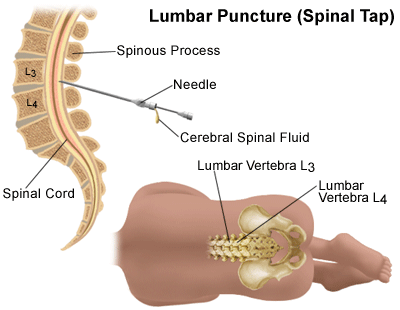lumbar puncture

A lumbar puncture, also known as spinal tap, is a procedure carried out under local anesthetic in which cerebrospinal fluid is withdrawn by means of a hollow needle inserted into the subarachnoid space in the region of the lower back (usually between the third and fourth lumbar vertebrae). The fluid obtained is examined for diagnosis of meningitis, multiple sclerosis, and various other disorders of the brain and spinal cord. Lumbar puncture may also be performed to inject agents into the subarachnoid space.
The procedure is usually without risk to the patient, but with patients with raised intracranial pressure it may be hazardous. CT scanning and MRI scanning prior to the lumbar puncture have greatly reduced the risk of performing the test in patients with unsuspected and raised intracranial pressure. The commonest side-effect of the procedure is a headache that is worse on standing and reduces on lying down.


